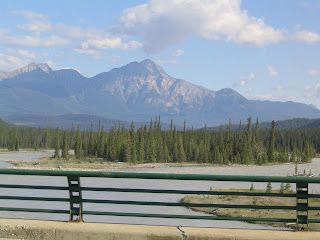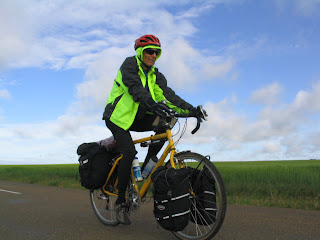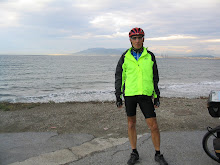 (Published in SPOKES: March 2009)
(Published in SPOKES: March 2009)I have long wanted to cycle the Northern Neck region of Virginia but like most good things it just had to wait until the time was right. At the prodding of SPOKES, I finally did it and had a wonderful cycling experience. I cannot remember having as much fun cycling as I did during the 3 days my cycling friend Larry and I spent on the Northern Neck. The October weather was on the cool side but not cold. The traffic was very minimal and the roads were great and mostly flat. However, that is not what made the trip so wonderful. My joy came from being relaxed and not being concerned about mileage. In just 3 days, we stopped at more coffee shops, historic sites, and scenic areas than I did crossing the United States in 90 days; at least that is what it seemed like. I think some of the sites were more powerful than when I first saw the Tetons; not that they were better, far from it, but rather my mind was in a far better place. Cycling the Northern Neck was truly delightful.
The Northern Neck is east of Fredericksburg, Virginia and flanked by the Potomac River on the north, the Rappahannock River on the south and the Chesapeake Bay to the east. According to WIKIPEDIA, the Northern Neck has “1,100 miles of shoreline containing beaches, marinas, old steamship wharfs and small towns that date back to colonial times.” It is about 100 miles from Fredericksburg to the southeastern tip of the Northern Neck, which is just east of the town of White Stone.

While cycling on the Northern Neck offers isolated rural areas, it is not without its great small towns and full services. According the RIVAH VISITOR’S GUIDE the Northern Neck has plenty of places to stay including over 50 motels, bed and breakfasts, and resorts. In addition, it has almost 2 dozen campgrounds and several canoe and kayak rental locations. This guide also reports nearly 200 places to eat and several vineyards to visit and taste. However, we did not find any bike shops. The RIVAH organizes the Neck’s offerings by its 4 counties: Westmoreland, Richmond, Lancaster, and Northumberland. Since I grew up in a Northumberland county in Pennsylvania, this Virginia County has a special place in my heart.
It took us about 2 hours to drive from Northern Virginia to start our first ride on the Northern Neck.
Three rides for 3 days
It was difficult to plan rides that would let us experience the Northern Neck in just 3 days. Therefore, we focused on cycling near its water boundaries. Our first trip started on the Potomac River at Westmoreland State Park. (While we used motels on this trip, we saw that the park has tent camping and cabins.) Before mounting our cycles, we stood on the rivers edge watching the wind create havoc on the water. Even though the cool and windy weather by the water was challenging, we stayed long enough to see either ospreys or eagles (sorry that I don’t know which) circling their nests and looking for food. Leaving the park, we began a 30 mile loop that took us through the countryside past Stafford Hall Plantation, the birthplace of Robert E. Lee, and into the town of Montross where we made our first café stop. In The Art of Coffee café
 we were greeted by the owner and her friendly staff. We had excellent coffee and sandwiches while enjoying the café’s art gallery. The owner displays and sells her paintings as well as the paintings and crafts created by other Northern Neck artists. From there we continued southwest through mostly agriculture areas toward the Rappahannock River. Finally, we completed our loop by heading northeast back to the Park. The only traffic that we encountered on this trip was on this last section where we cycled several miles on Route 3. However, the traffic was still minimal and drivers courteous.
we were greeted by the owner and her friendly staff. We had excellent coffee and sandwiches while enjoying the café’s art gallery. The owner displays and sells her paintings as well as the paintings and crafts created by other Northern Neck artists. From there we continued southwest through mostly agriculture areas toward the Rappahannock River. Finally, we completed our loop by heading northeast back to the Park. The only traffic that we encountered on this trip was on this last section where we cycled several miles on Route 3. However, the traffic was still minimal and drivers courteous.After loading our bikes, we drove east for our next day’s ride that would take us along the Rappahannock River out to the Chesapeake Bay before heading inland. The second day’s ride started in Irvington on the south eastern part of the Neck. According to the town’s webpage, Irvington dates from 1891 and was part of the steamboat route between Norfolk and Baltimore. The town displays part of a steam boat at its Steamboat Era Museum and offers B&B and resort accommodations, farmers markets, and charter boating.

From Irvington it was only a short ride east to the town of White Stone where we found another great café that roasted its own beans. From there it was only 7 miles east to the Chesapeake Bay. Since this road only leads to the Bay through a low density residential area, we had minimal traffic. After doubling back to White Stone, our route took us north to the town of Kilmarnock. According to the town’s webpage, Kilmarnock was settled in the mid-1600s. To get a flavor for the town, we stopped at The Talk of The Town Coffee House were we met more friendly people. One of those we met was a former bike racer out of Richmond who wished that he had the time and conditioning to join us. Little did he, or we, know that our day would require only minimal conditioning.
Our route through Kilmarnock was to loop us northeast before coming back into town for a loop to the southwest giving us a 60 mile day. This is where relying totally on a GPS can get you into trouble. I recently purchased a GPS for my cycling adventures. This trip was my first real test in using it. I liked not having to read a map and just follow along the route shown on the screen. However, the GPS got confused in Kilmarnock with my planned route. I wanted to do a figure eight that went through the town
 twice. After our stop, I could not get the GPS to show me the northeast loop. It kept showing me the southwest route that I planned for the second loop through Kilmarnock. So we just gave up and went with the flow and headed southwest. Initially, I thought that the loss of 20 miles would be disappointing. However, as the day turned out the GPS was smarter than me.
twice. After our stop, I could not get the GPS to show me the northeast loop. It kept showing me the southwest route that I planned for the second loop through Kilmarnock. So we just gave up and went with the flow and headed southwest. Initially, I thought that the loss of 20 miles would be disappointing. However, as the day turned out the GPS was smarter than me.We followed our destiny and cycled southwest in a wide circular loop back toward Irvington. On the way, we stopped at the historic Christ Church and received a tour and warm hospitality from its docents. After our “long” ride we wanted to have some refreshments as we neared the town of Irvington. First, we found a winery but it was closed for the day. While disappointed we cycled on and found a café called The Local. It was opened and we rationalized that coffee was probably better for cyclist than wine. One of The Local’s claims to fame is its ice cream. Larry raved over the ice cream’s rich flavor and texture and went into a 2 scoop mode. To burn off all our extra calories we cycled around Irvington for one more look at the Rappahannock Rive before packing up our bikes.
Our third ride started in Warsaw and would take us past another section of the Rappahannock River. Since we had to check out of the motel by 11 a.m., we started our ride early so we would have time to get back for showers before heading home. This meant a very cool start with the October temperatures in the 40 degree range. While Larry was prepared with the correct clothing, I did not have leg or finger coverings and I was cold for the first hour. After that Larry was overdressed and I was comfortable. This 20 mile ride took us northwest before heading southeast toward the river. Along the way we ran into road construction where a new bridge was near completion. Rather than making us take the detour, the workmen allowed us to cycle through, thus keeping us on our route. This route gave us our first and only “hill.” While not much of a climb, it was followed by a long downhill. What surprised me was that we were at water level before and after the hill so it was hard to explain why the downhill seemed much longer than the climb. I guess it was all part of the fantastic journey.
As we got closer to the river, we again saw lots of water birds and deer. We stopped at Naylors Beach Campground located on the bank of the Rappahannock River. While the campground was deserted at this time of the year, it looked like a great place to stay. With the many campgrounds we saw I could easily envision taking a loaded tour through the Northern Neck.
Stopping traffic with a Trike

While I cycled with a standard touring bike (my “yellow bike”), Larry used a Catrike—a very low bike with two 20-inch wheels in the front and one 20-inch wheel in the rear. Every day we were stopped and asked about Larry’s trike. We must have been stopped a dozen times but it became part of our relaxed journey. We forgot the miles and just talked. One man passed Larry and motioned for him to pull over. Larry figured that he was going to catch hell for cycling on the road with what some consider a “toy.” However, the man told Larry that last week he tried a similar trike in Vienna, Virginia. As it turned out, it was the same place that Larry purchased his trike (http://www.bikesatvienna.com/). On the second day in Irvington, the Tides Inn Resort’s lawn crew came to a halt as we cycled by. There we spent about 45 minutes discussing the pros and cons of such a bike. On our last day, a huge orange state highway truck stopped in the middle of the road, the driver turned off its motor and the crew started the all too familiar questions about Larry’s trike.

Lots of history
If historical sites interest you, your bicycle is an excellent way to explore the Northern Neck. According to the RIVAH, there are over 70 museums and historic sites on the Neck. Settlements on the Northern Neck date back to the 1600s. One of the oldest and very interesting structures is Christ Church, located just north of Irvington. The original wood structure was built in 1670 and in 1735 it was replaced by the current brick structure. The church has been restored and is still used, but it was never heated or air conditioned. The church still has its original high-backed box pews that view a towering triple deck pulpit. Sitting in one of box pews I could almost experience an early American preacher standing high up in the pulpit’s third level and raining “fire and brimstone” down upon me because I sometimes cycle on Sundays.
A jump in time and distance will take you to the birthplace of George Washington on route 3 in Westmoreland County. Today, George’s mother, Mary Ball has her own museum in nearby Lancaster County. In Colonial Beach, a short distance away from George’s birthplace you can find the birthplace of James Monroe, our fifth president. Further east along route 3 you can visit the birthplace of Robert E. Lee at Stratford Hall Plantation. This plantation built in the 1700s has been restored and is open to the public.

If presidents and historic churches are not your thing, you can cycle by Hayden Hall in Irvington. Scandalous as it seems today, Sarah Wilder the mistress of Hayden Hall was married at the age of 12. She must have grown up quickly because she and her husband, Tom Hayden, had 11 children in this home which dates from the 1800s. While the RIVAH reports that Sarah’s ghost haunts the home to this day, you will not have an opportunity to meet her for Hayden Hall is a private residence.
Going further south
Before heading home we had the opportunity to cross over the Rappahannock River at White Stone and drive up to Tappahannock, Virginia about 45 miles away. The area south of the Rappahannock, north of the York River, and west of the Chesapeake Bay is called the Middle Peninsula of Virginia. I had not been to this part of Virginia either and it looks like another great place to explore on my yellow bike.








































